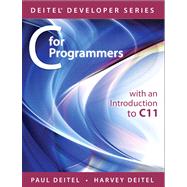The professional programmer’s Deitel® guide to procedural programming in C through 130 working code examples
Written for programmers with a background in high-level language programming, this book applies the Deitel signature live-code approach to teaching the C language and the C Standard Library. The book presents the concepts in the context of fully tested programs, complete with syntax shading, code highlighting, code walkthroughs and program outputs. The book features approximately 5,000 lines of proven C code and hundreds of savvy tips that will help you build robust applications.
Start with an introduction to C, then rapidly move on to more advanced topics, including building custom data structures, the Standard Library, select features of the new C11 standard such as multithreading to help you write high-performance applications for today’s multicore systems, and secure C programming sections that show you how to write software that is more robust and less vulnerable. You’ll enjoy the Deitels’ classic treatment of procedural programming. When you’re finished, you’ll have everything you need to start building industrial-strength C applications.
Practical, example-rich coverage of:
- C programming fundamentals
- Compiling and debugging with GNU gcc and gdb, and Visual C++®
- Key new C11 standard features: Type generic expressions, anonymous structures and unions, memory alignment, enhanced Unicode® support, _Static_assert, quick_exit and at_quick_exit, _Noreturn function specifier, C11 headers
- C11 multithreading for enhanced performance on today’s multicore systems
- Secure C Programming sections
- Data structures, searching and sorting
- Order of evaluation issues, preprocessor
- Designated initializers, compound literals, bool type, complex numbers, variable-length arrays, restricted pointers, type generic math, inline functions, and more.
Visit www.deitel.com
- For information on Deitel’s Dive Into® Series programming training courses delivered at organizations worldwide visit www.deitel.com/training or write to deitel@deitel.com
- Download code examples
- To receive updates for this book, subscribe to the free DEITEL® BUZZ ONLINE e-mail newsletter at www.deitel.com/newsletter/subscribe.html
- Join the Deitel social networking communities on Facebook® at facebook.com/DeitelFan , Twitter® @deitel, LinkedIn® at bit.ly/DeitelLinkedIn and Google+™ at gplus.to/Deitel








